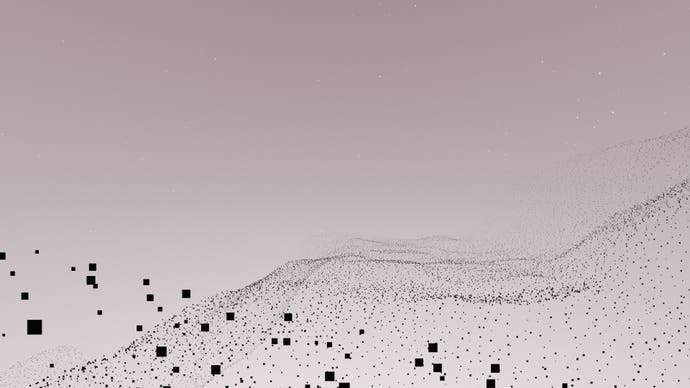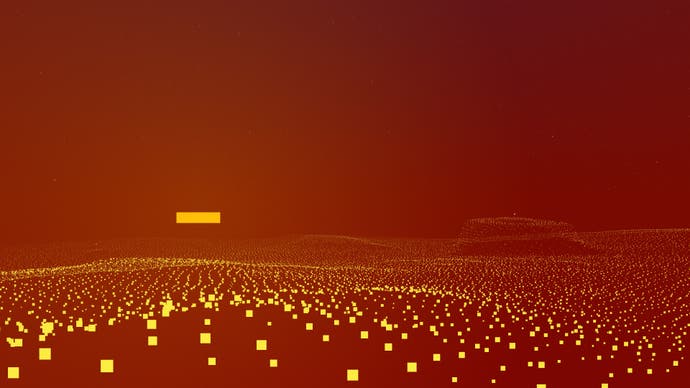Periphery Synthetic is playable by sound alone - is it the next step in accessibility for the blind and visually impaired?
"I don't think it's a lot to ask."
Close your eyes. It's an exercise we've all tried: navigating through touch, memory, and educated guesses. Invariably, we panic and open them immediately or run into something we were sure wasn't there. You can do the same in a video game and have a similar experience of playing chicken with obstacles, both real and imagined, in your path. Though that is the closest many sighted players will come to the realities of blind and visually impaired gamers.
A clutch of games exist, however, in which this is not the case. It's not a crowded field, but it received a new entry last month in Periphery Synthetic. A nonviolent, undemanding space exploration designed as, according to its developer shiftBacktick, "primarily an auditory experience to be playable without seeing the screen."
It's a meditative experience that sees the player roaming over vast plains in search of materials to visit other planets. All of which is represented visually by a succession of squares and audibly through the combination of two chords and their harmonics and inversions, to create a soundscape of over 100 simultaneous and unique sounds that make the game playable by sound alone.
Indeed, in my own explorations of Periphery Synthetic, even as a sighted player, I found myself switching off the graphics (one of a suite of accessibility options) and navigating by sound alone. Much as we all had, I found myself navigating as if I'd closed my eyes, and yet in the place of unseen obstacles I found a navigable, relaxing, and compelling loop in which I could become lost in the noisome vacuum of Periphery Synthetic's equitable gameplay.
Despite a long history of audio games, the idea of playing without seeing what is often regarded as a visual medium still takes some by surprise - especially online. There are trolls, naturally; but also a sincere misunderstanding, according to psychology PhD researcher, Chris Leech, the scope of sight loss included within the syntactical definition of "blind and visually impaired."
"When people hear 'blind' they often assume this means someone who can visualise nothing at all," he tells Eurogamer. "But many visual conditions mean people can see shapes, blurs, or lights. Vision - the light your eyes process and how your brain perceives and translates this - is, unsurprisingly, really complicated."
For all that variation, the blind players and developers Eurogamer spoke to are united in the consequences of that in gaming. It's an unseen labour and cost - of larger monitors, sitting closer to the screen, and playing on low resolutions to enlarge increasingly small UI. For others, it's trial-and-error and memorisation: logging each sound, each input. Though, even then so much information is unavailable.
"Since we can't enjoy the graphics or have audio descriptions to understand the scenery," Vabax, a blind content creator, says, "we often have to rely on friends or others to describe the design of characters or game environments."

A more mainstream focus on accessibility in the last few years has driven a greater concentration on blind accessibility. Though, few games have managed to alleviate the need for assistance from sighted players. One prime example would be The Last of Us Part 1 - and, to a slightly lesser extent, Part 2. In particular, it's robust navigation assist which points players towards objectives while also considering obstacles along the route and the ability to audibly ping enemies and items. This, a key feature in Periphery Synthetic's chill collectathon too.
In concert with a wider breadth of blind accessibility, The Last of Us Part 1 raised the bar and became an emotional touchstone for blind players used to inaccessible experiences. "I swear I was going to cry," Shaylyn Baker, an accessibility consultant, says. "[It] meant so much to me, and I knew, with this groundbreaking work, that there would be more games to follow."
Follow they did - albeit slowly. Mortal Kombat 1 and Forza Motorsport built upon that work, while Stories of Blossom, 1428: Shadows over Silesia, and now Periphery Synthetic have set the benchmark in the indie space.
Others have come close. God of War Ragnarök included a significant focus on unassisted play but ultimately fell short while, on paper, Spider-Man 2 has the makings of a blind accessible game but would benefit from the focussed assists of The Last of Us Part 1 to be truly playable without assistance. Though limited in its broader accessibility, even Final Fantasy 7 Rebirth has been cited as surprisingly blind-friendly thanks to combat slow-down and, yes, yellow paint.

The selection, however, remains limited. Sighted players - and even some partially sighted players - can look forward to regular releases, but for SightlessKombat, accessible gaming officer for RNIB, the gap is much longer. "I might be forced to wait months or even years between fully accessible releases due to developers or publishers not including the features I need," he says.
Those features, like disability itself, are variable but a consensus emerged among players and developers we spoke to on what is most important. First, interfaces must be easily navigable. Something, according to Vabax, that may give mobile gaming an edge. "The simplicity of controlling the game through touch gestures, such as swiping and tapping, allows for a more intuitive experience," he says. "This can be less overwhelming than managing multiple buttons on a console controller."
This needs to be deployed in concert with integrated screen readers, and audio description to add context to the game's visuals. Across all of which a robust, parameterised soundscape is vital, to the point that some otherwise inaccessible games - like early Pokémon titles - are surprisingly playable for some blind players thanks to their sound design and linear progression. Ultimately, if information is given to sighted players, it needs to be communicated to blind players too for that information to be rendered playable.
Implementing these brings its own challenges and no one is pretending otherwise. Yet, that task is made all the harder by development tools that are slow to integrate the means to do so and development environments that remain inaccessible.


For Talon, a blind developer, the tools available focus too much on the player and not at all on making these tools accessible to developers. "This makes it impossible to use these engines as a blind game developer," he says. "The only real way out is to roll my own tools which is a very big undertaking."
Unreal and Godot have recently started paying some attention to accessibility - Unreal recently announced support for third-party screen readers, for instance - but this remains geared towards making it easier to implement in games rather than integrating that support into the tool itself. A positive move, for sure, but one that does nothing to help blind developers.
"I would love to use these tools in my own future games, but also potentially pursue a career in game sound," says Piotr Machacz, a game developer and sound designer. "But because these tools don't work with screen reading software I can't do either."
Writing about accessibility, the most common solution offered by sources - most often consultants - is to hire more consultants. It's true, bringing disabled voices into the development process from the start makes for more accessible games. Yet, it's notable how many barriers there are to bringing lived experience directly into the industry and the obstacles that creates for increasing the games playable without assistance.

While user-made plugins and mods exist to mitigate this, these are another extra labour and Soft Leaf Studios' director, Conor Bradley, acknowledges that "even then these are a workaround that could be avoided if the game engines did a better job at giving developers access to the tools they need."
Instead, it falls to the community to prop up players and developers in an inaccessible landscape. Whether that's sighted players assisting blind players or, as shiftBacktick cites as a major aid in their own development, helping educate and drive accessibility for sighted developers.
All of which is to say there is an immense amount of work going into making games playable for blind players. Labour that could be mitigated with a greater consideration of accessibility across the broader industry. Even consultancy, now a well-established tool for studios, remains an inaccessible proposition.
In particular, SightlessKombat cites the need for more remote options to counter the physical and financial toll of travelling for opportunities. Something made more pertinent by a worsening COVID-19 pandemic that not only promotes further disability but is also being treated with an alarming apathy by large swathes of the accessibility community - to the increasing inaccessibility of said community.

Indeed, since I last explored blind accessibility in 2023, little appears to have changed in terms of what's needed going forward. Greater education of the varied needs of blind players is required, yes, and better tools too. But again and again it is lived experience - across development, testing and QA, and broader community efforts - that is absent from the majority of games.
It's not the most optimistic statement and perhaps belies the progress that's of the past few years. As much as things stay the same, however, Periphery Synthetic's release is a timely reminder that the work is being done and that a growing precedent of accessible games is showing what is possible in making video games fully playable for blind players. In particular, there is hope that we can continue to push back against how exclusive gaming remains and mitigate the labour that comes with being blind and visually impaired in the gaming space. This, to better allow more of us to access the medium we love.
"There's no real way to describe being able to not have to worry about additional faff just to enjoy something," Leech says. "Your disabled friends, family, colleagues, and community members are expending additional effort all the time. Just to exist. Just to try and get by. I don't think it's a lot to ask to let us enjoy our video games in peace. Just like everyone else."


